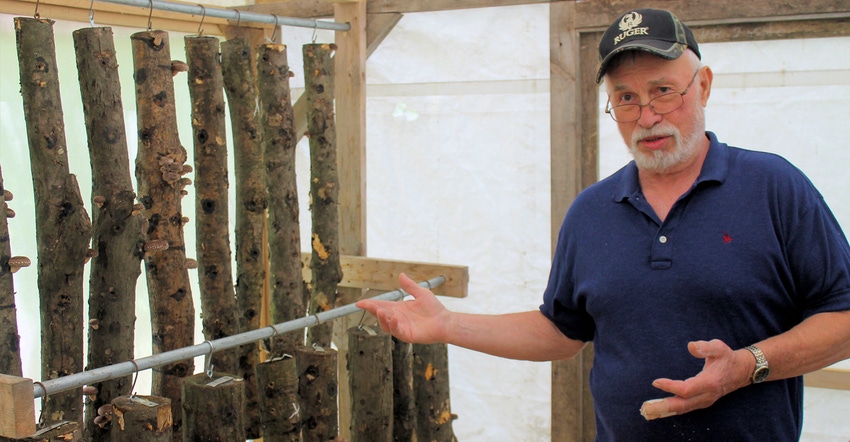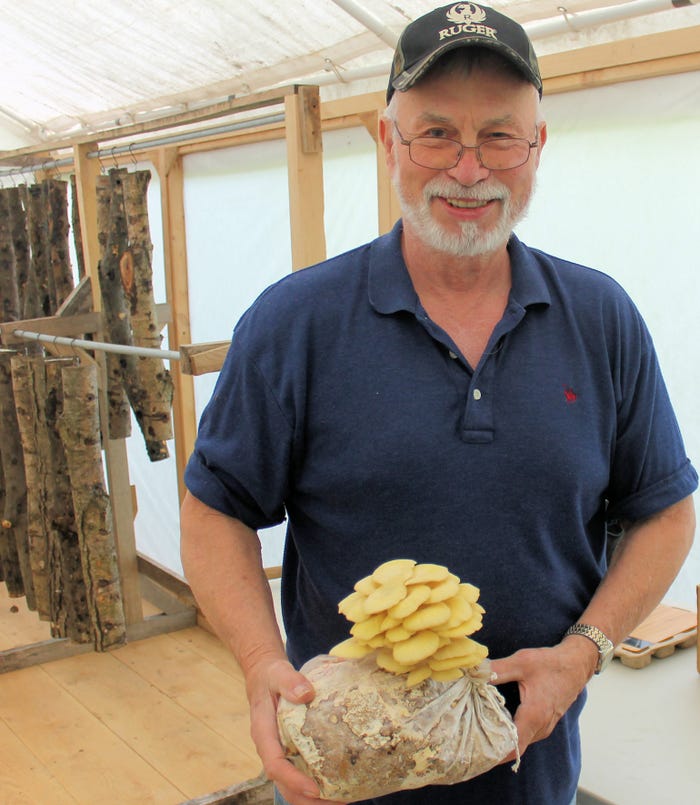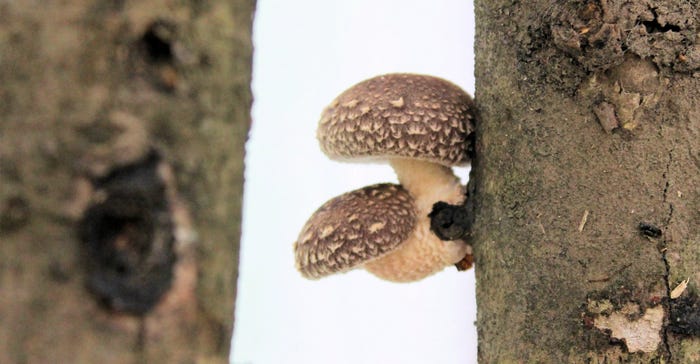June 19, 2018

Ask for help. Ask how you might help. That simple practice helped Bob Miller become a mushroom farmer and secure one of his first two restaurant customers.
Miller owns 23 acres of Southern Tier forestland near Greene, N.Y. When he retired from the natural gas industry, the woods on his Three Tree Mushroom Farm needed thinning.
Miller had read about raising log-grown mushrooms and started asking for help. He visited other operations to get ideas. Then he watched videos made by Cornell University's Ken Mudge and Steve Gabriel, and downloaded shiitake production best management practices from USDA's Sustainable Agriculture Research and Education program.
 OYSTERS ANYONE? Miller's first crop of yellow oyster mushrooms, grown in plastic bags filled with wood pellet sawdust, is harvest-ready.
OYSTERS ANYONE? Miller's first crop of yellow oyster mushrooms, grown in plastic bags filled with wood pellet sawdust, is harvest-ready.

Finally, he was confident to go the next step — harvesting oak and maple logs to inoculate the mycelium that feeds mushroom fungi. Mycelium take 9 to 12 months to saturate logs and provide those nutrients.
His first crop came into fruit in 2017 at the same time another producer supplying local restaurants was injured and couldn't maintain his crop. So, Miller approached Gary Kurz, owner of The Silo Restaurant in nearby Greene.
"Bob asked if he could provide me with mushrooms when he heard my regular supplier was out of business," Kurz says. The restaurant serves specials such as a pan-seared beef au poivre filet with Miller's mushrooms. Kurz's wait staff inform diners that the shiitake and oyster mushrooms are locally-sourced, 100% organic, log-grown mushrooms.
Word of mouth drives local sales. Wherever he goes, Miller asks people if they're interested in trying his mushrooms. Clientele include his barber, another restaurant and the physical therapist who helped him recover from knee surgery.
Experimental growing mediums
Miller has had good results with certain types of mushrooms grown in sawdust. He has tried some in (spent brewer) grains. "I'm trying oyster mushrooms covered in paper bags on logs arranged like a totem pole," he adds.
He staggers his "shocking" schedule to support weekly production all summer. To extend sales into the fall, he has stacked and covered up to 65 logs in a shed for warmth. For 2018, he improved his fruiting room. To build production capacity and bring a third restaurant onboard, he set up a greenhouse to grow mushrooms in plastic bags.
Seek experienced advice
Everyone venturing into a new enterprise wishes they had sought out help for something. Miller, for instance, purchased a dehydrator. "Then I learned from Ken (Kenneth Smith, Chenango County Cooperative Extension executive director) that to sell dried mushrooms requires a special kitchen license and a fee of about $400 every two years. I'm not yet doing enough business to make that affordable, but it may be a future step."
With a value-added forest project grant from New York Farm Viability Institute, Smith is educating forest owners on ways to realize income from woodlands. "Some 66% of New York's 35,500 farms have large amounts of forest that increase property taxes," Smith says. "Fewer than 2,000 of them are deriving income from their woods."
 TREE FRUIT: Young log-grown shiitake mushrooms sprout.
TREE FRUIT: Young log-grown shiitake mushrooms sprout.

"Woodlots can produce a substantial economic return each year through such enterprises as mushrooms, maple, firewood, timber, hunting leases and rental cabins," he adds. His NYFVI grant provides help for farmers looking to develop such businesses. Smith can be reached at 607-334-5841, ext. 19.
"This project is a great example of helping farmers recognize and develop new business opportunities," says NYFVI Director David Grusenmeyer. "A sound business and marketing plan is critical to success."
Shiitakes: A profitable agroforestry crop
Cultivation of shiitake mushrooms offers farmers and woodlot owners a good opportunity to utilize forested lands while turning a profit, says Steve Gabriel, Cornell Agroforestry Extension specialist. Startup costs are low.
"Our research indicates profitability can be achieved in the second or third year with good business planning, dedicated production and operating efficiency," he adds. Gabriel calculates the basic numbers for raising shiitake mushrooms on logs at:
• average cost, including labor at $12 per hour: $4.74 per log
• average production: ¼ to ½ pound of mushrooms per flush, 2 to 3 flushes per season
• fresh mushroom sales: $12 to $16 per pound retail, $10 to $12 per pound wholesale
• dried mushroom sales: $6 to $8 per ounce
Cornell's Small Farms Program conducted a survey of specialty mushroom growers this spring. That survey requested input from growers throughout the Northeast and south to Maryland. The data will be used to develop further research and programming. For more information, factsheets, guides and videos, see cornellmushrooms.org.
Dunn writes from her farm at Mannsville, N.Y.
About the Author(s)
You May Also Like




